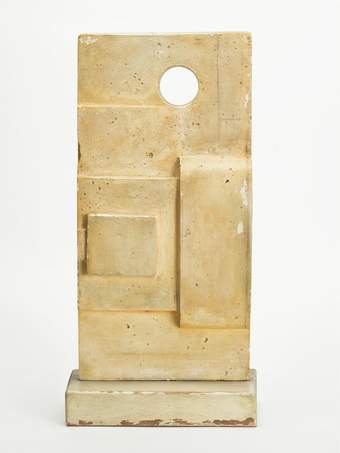Plaster maquette, ‘Model for Monumental Stela’
[c.1936]

'Model for Monumental Stela' c.1936 is a solid plaster cast, shown by x-rays to have been made in one spell, either cast, or carved from a block of plaster. There are filing marks on the surface of the plaster and air bubbles that indicate the cast was made quickly, consistent with its use as a working model. The cast is attached to a painted wooden base with two metal brackets, affixed with six screws on each bracket on the reverse side. The brackets have been painted over. The cast has been coated with shellac, which has yellowed with age. The face of the model is formed of a layered relief of receding squares and rectangles adjacent to an arched protrusion which is flush to the right side of the cast. A cylindrical hole pierces the cast, positioned to the top right of the model. A receding plane is formed on the top left face of the model from the lowest point of the pierced hole to the left and top sides of the cast. There are pencil marks running vertically from the top right down to the centre of the top of the arch, and horizontally from the right side to meet the vertical line. The left-hand narrow side is marked by two cavities caused by air bubbles in the plaster. Further rectangular markings in pencil are found in the lower half of the left-hand side. On the reverse side of the model, to the right on the lower half is a circular concavity measuring roughly 100 millimetres in diameter. The hole to the top left-hand side appears on a rectangular raised plane. Vertical marks in pencil run almost the length of the model, from the top, on the far left. Cavities caused by air bubbles are found in the upper and lower part of the right hand narrow side of the model. A long rectangle is marked in pencil that sits within the arched plane.
A label affixed to the base of the model bears the name 'John Funk' and a San Francisco address. There was a Bay Area architect of that name who is known to have visited London in the 1930s. Despite research in the University of California at Berkeley, where the Funk archives are held, nothing more has emerged about the connection. The Estate have concluded that Funk may have acquired or been given the cast from Hepworth, and it was intended to travel to America but for some reason remained in London.
Further Reading:
J.P. Hodin, 'Barbara Hepworth', Neuchâtel 1961
Sophie Bowness (ed.), 'Barbara Hepworth: The Plasters', London 2011
- Collection Owner
- Collection
- Tate Archive
- Acquisition
- Purchased by Sir Alan Bowness and Sophie Bowness, and generously donated to Tate, 2016
- Reference
- TGA 201618
1 object in this collection
- Title
- Plaster maquette, ‘Model for Monumental Stela’
- Date
- [c.1936]
- Description
- 'Model for Monumental Stela' c.1936 is a solid plaster cast, shown by x-rays to have been made in one spell, either cast, or carved from a block of plaster. There are filing marks on the surface of the plaster and air bubbles that indicate the cast was made quickly, consistent with its use as a working model. The cast is attached to a painted wooden base with two metal brackets, affixed with six screws on each bracket on the reverse side. The brackets have been painted over. The cast has been coated with shellac, which has yellowed with age. The face of the model is formed of a layered relief of receding squares and rectangles adjacent to an arched protrusion which is flush to the right side of the cast. A cylindrical hole pierces the cast, positioned to the top right of the model. A receding plane is formed on the top left face of the model from the lowest point of the pierced hole to the left and top sides of the cast. There are pencil marks running vertically from the top right down to the centre of the top of the arch, and horizontally from the right side to meet the vertical line. The left-hand narrow side is marked by two cavities caused by air bubbles in the plaster. Further rectangular markings in pencil are found in the lower half of the left-hand side. On the reverse side of the model, to the right on the lower half is a circular concavity measuring roughly 100 millimetres in diameter. The hole to the top left-hand side appears on a rectangular raised plane. Vertical marks in pencil run almost the length of the model, from the top, on the far left. Cavities caused by air bubbles are found in the upper and lower part of the right hand narrow side of the model. A long rectangle is marked in pencil that sits within the arched plane.
A label affixed to the base of the model bears the name 'John Funk' and a San Francisco address. There was a Bay Area architect of that name who is known to have visited London in the 1930s. Despite research in the University of California at Berkeley, where the Funk archives are held, nothing more has emerged about the connection. The Estate have concluded that Funk may have acquired or been given the cast from Hepworth, and it was intended to travel to America but for some reason remained in London.
Further Reading:
J.P. Hodin, 'Barbara Hepworth', Neuchâtel 1961
Sophie Bowness (ed.), 'Barbara Hepworth: The Plasters', London 2011 - Reference
- TGA 201618

